The Lancaster Colonial Settlement Project
Project Overview
The Lancaster Colonial Settlement Project is a multi-disciplinary research effort of the Archaeology program at Millersville University of Pennsylvania. The purpose of the project is to locate, identify, excavate, and study archaeological remains of colonial-period settlement in Lancaster County, Pennsylvania. The investigation incorporates the work of historians, botanists, historic architects, and palynologists, in conjunction with the primary focus on historical archaeology conducted by the Archaeology program at Millersville University, under the direction of Dr. Tim Trussell.
Background
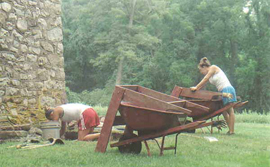 |
| Millersville archaeology students Kari John and Nancy Powell excavate a 5x5 test unit at the John Jacob Huber House (ca. 1746)at the Elizabeth Furnace Plantation site in the summer of 2005. This unit produced a wide array of artifacts, including a 1797 one cent piece and the base of a creamware 1/2 pint mug (ca.1765). |
The development of Lancaster County is of particular importance to American history. Located in one of the most fertile agricultural regions in the world, Lancaster was the most populous inland county in America at the time of the Revolutionary War. Population growth was so strong historically that the region produced large population out-migrations throughout the 18th and 19th centuries. These outflows of people formed the core of initial settlement in many subsequently developed areas, including regions in South Carolina, Ohio, West Virginia, Tennessee, and the Shenandoah Valley of Virginia. For this reason, Lancaster County has long been considered an important "culture-hearth" - a highly influential region where initial development had profound cultural, political, and economic implications for many other areas over time. For example, it has been estimated that 40% of all Americans can trace at least one ancestor back to Lancaster County, making the area a national focal point for genealogical research.
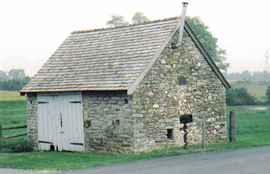 |
| The Mylin Gun Shop site (ca. 1719). |
The attention given to Lancaster County by historians and genealogists has not been matched by comparable attention from historical archaeology. This is
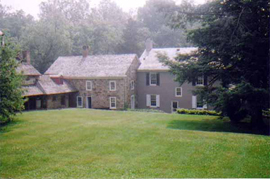 |
| This grouping of buildings at Elizabeth Furnace Plantation shows a variety of architectural styles. The office and summer kitchen (left) are vernacular |
Historical archaeology has the potential to address these limitations. The artifacts in a site can be viewed as the unintended remains of the past, the residue of daily life inadvertently left behind as evidence of ordinary activities. Through the analysis of an archaeological assemblage, researchers can reconstruct past patterns of behavior, revealing underlying social assumptions and cultural influences. When combined with traditional approaches to document-centered history, archaeological research can be a powerful tool for investigating the past.
The value of the Lancaster Colonial Settlement Project, in short, is that it has the potential to shed new light on significant cultural processes influential in shaping the earliest period of colonial history in this area. Through later development and out-migration from the "culture hearth" of Lancaster County, these processes indelibly shaped the broader course of American history. Each of the sites being investigated presents particular challenges, but each has the potential to make unique contributions to our understanding through historical archaeology research.
Mylin Gun Shop
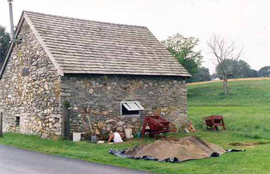
The Mylin Gun Shop was built in 1719 on the property of Martin Mylin, one of the original settlers in Lancaster County. Although the location of the original Mylin homestead is unknown, the Gun Shop still stands on the property. Historians have long been aware that a distinctive style of frontier rifle, combining elements of German and English gun-making with an innovative extended barrel for extraordinarily accurate marksmanship, was developed in Lancaster County in the early 18th century. Misnamed the Kentucky Long-Rifle, these frontier weapons are reputed to have first been made by Martin Mylin at this gun shop.
The Lancaster Colonial Settlement Project began test excavations in the summer of 2005 concentrating on testing the archaeological potential of the site, and addressing two areas of scholarly disagreement related to Mylin and the Gun Shop. First, some local architectural historians have claimed that the building identified as the Gun Shop could not have been used as a blacksmith/gun shop due to its architectural layout, specifically the absence of a standing chimney at one end and the absence of windows to provide enough natural light to do such work. Our excavations clearly revealed that blacksmithing was, in fact, done at the site. In addition to thousands of iron artifacts, fragments, and pieces of slag associated with blacksmithing, several broken sections of bar iron were recovered. As this bar-iron provided the raw material used by the blacksmith to work into the tools, nails, etc. produced at the shop, and because only a blacksmith would require such raw material, we can definitively state that the building functioned as a blacksmith shop. Interviews with practicing blacksmiths indicated that the level of natural light in the building would not have been a hindrance to such work. The lack of architectural evidence for an end chimney may be explained by the fact that Mylin, in the German architectural tradition, most likely built his chimney near the center of the building (in the manner of the Hans Herr house, for instance), rather than constructing an English-style end chimney. This free-standing chimney, no longer present, appears to have been removed at some point when the building ceased to be used as a blacksmith shop.
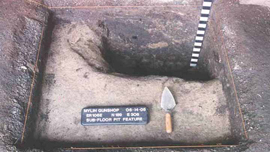 |
| This sub-floor pit was discovered during |
The second area of scholarly disagreement has proven tougher to address through historical archaeology thus far. While some local historians have suggested that Mylin was not a gunsmith, despite the presence of gun-making tools in his probate inventory, others have strongly disagreed. Unfortunately, our limited testing at this site has not, thus far, produced specific artifacts related to gun-making. It should be noted that the absence of such evidence does not prove, or disprove, the theory that Mylin was a gunsmith, and further testing will be needed to adequately address this question
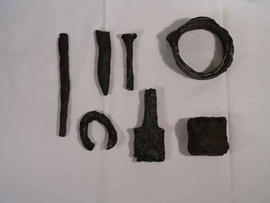
- Click here to view the Mylin Gun Shop Report (pdf)